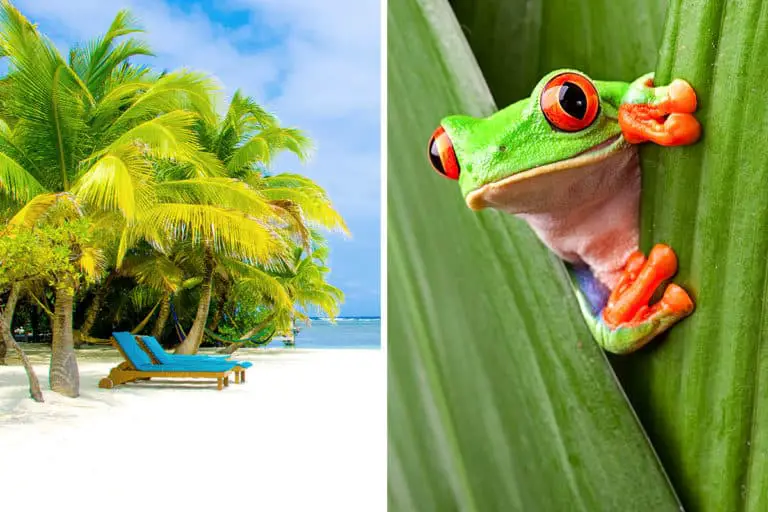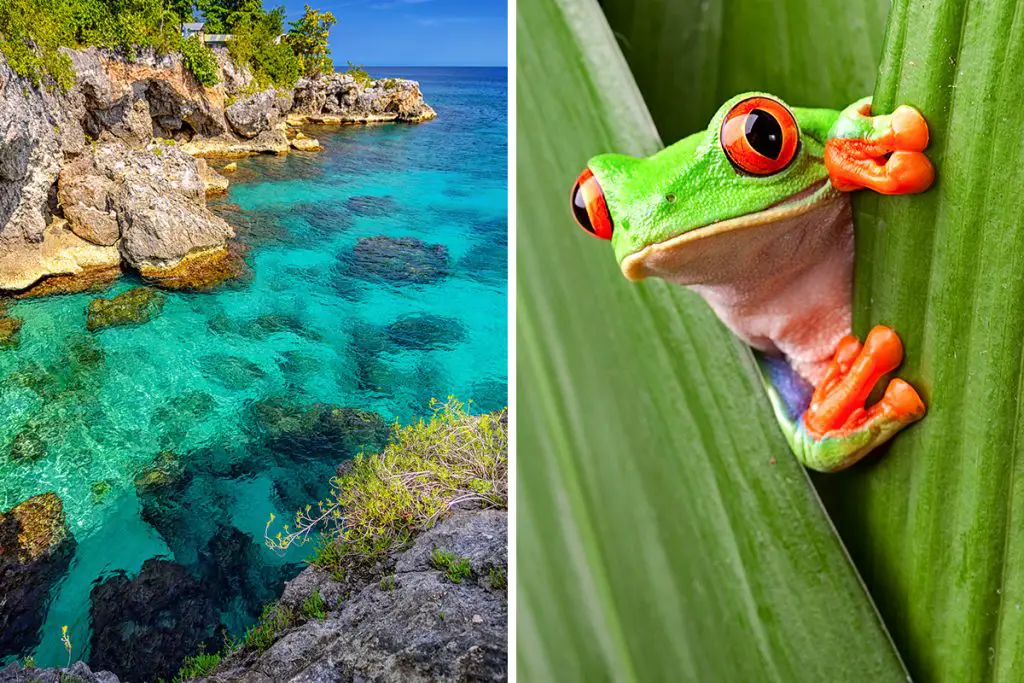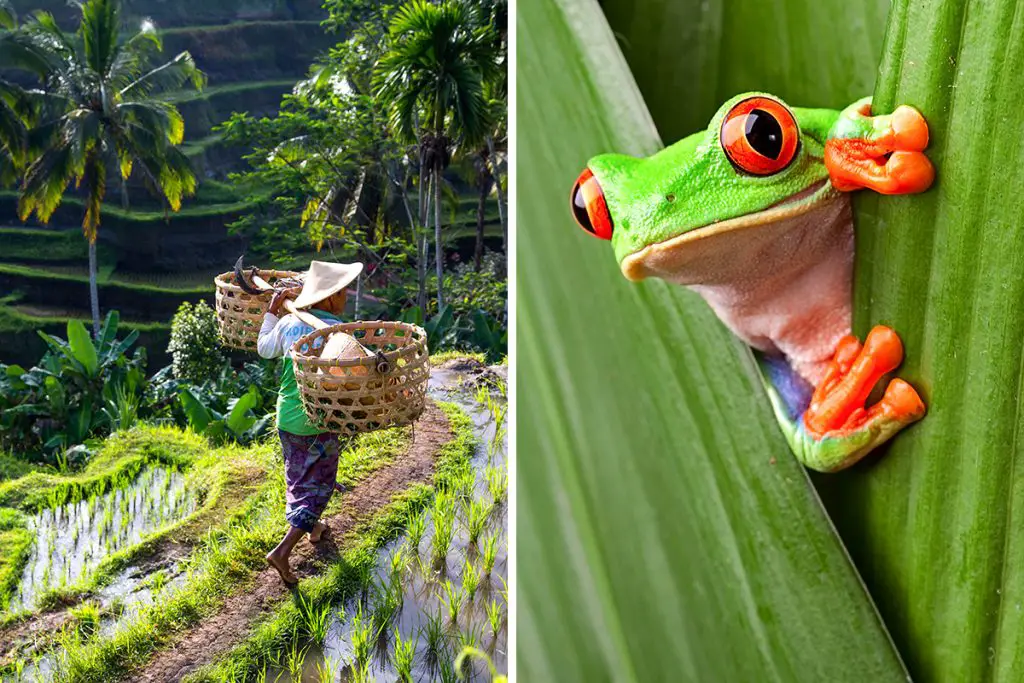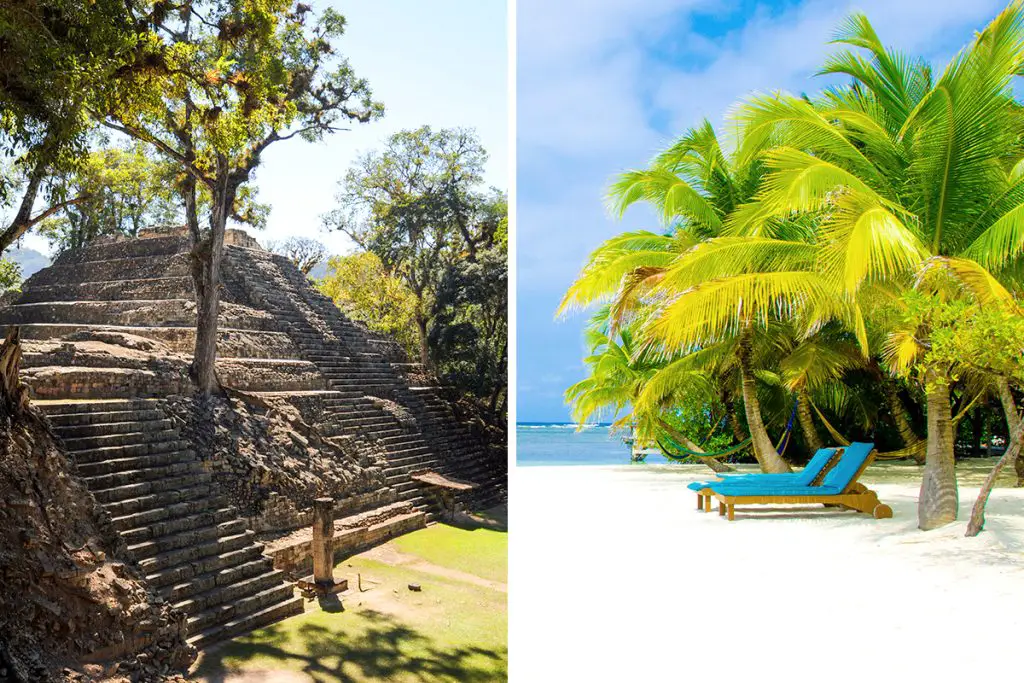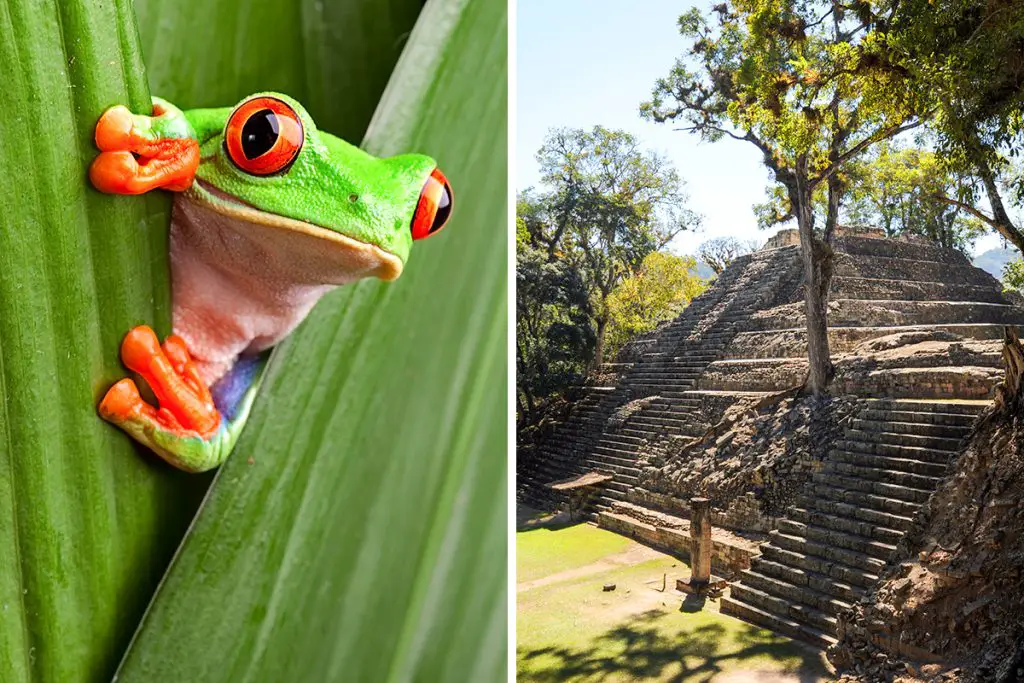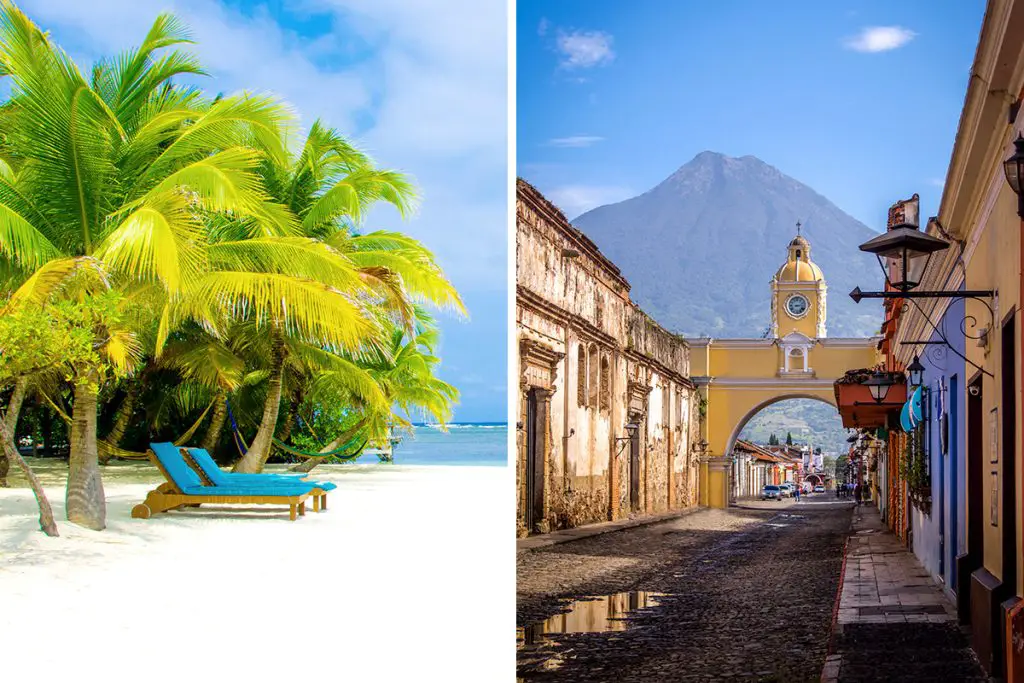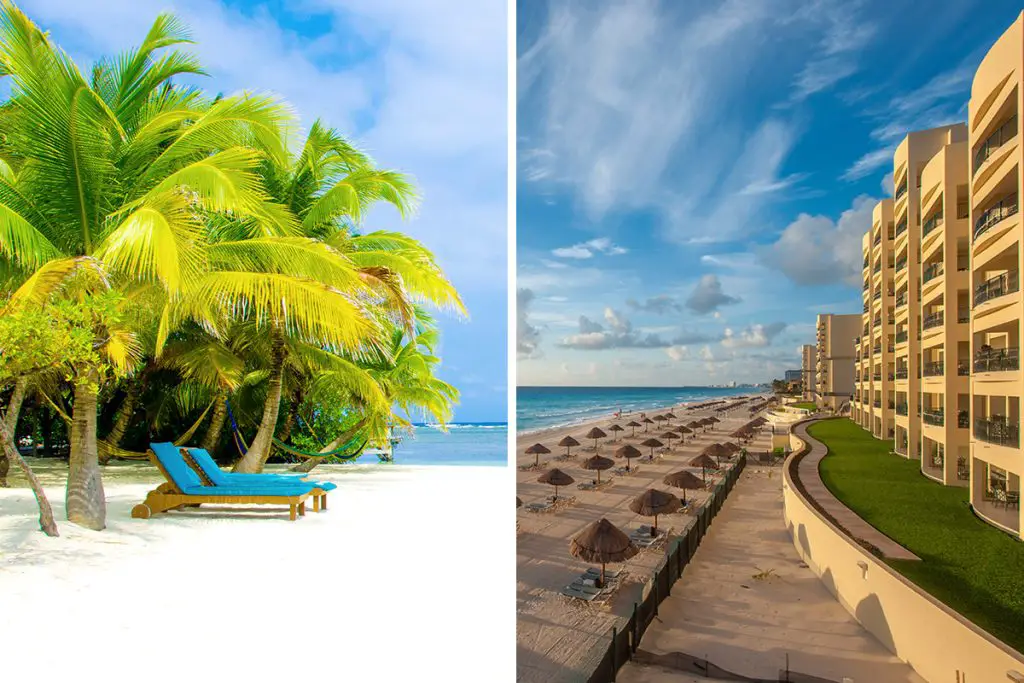Belize’s landscape and its aquatic features have given “tropical adventure” a whole different meaning. From Belize’s over 200 cays and Mayan heartland curiosities, Belize can be the best of both worlds.
Costa Rica’s charms have enchanted many visitors all over the world. Thanks to how it conserves its greatest commodity — Mother Nature herself. Here, ecotourism is king.
Costa Rica is the perfect blend of watersport beaches, lush greens, and a local philosophy that embraces peace and simplicity.
Belize
Central America is often overshadowed by the Caribbean’s all-too-famous islands. But, this underrated region packs quite a lot of punches.
Belize’s draws and best features have to be one of the most interesting there is in all the tropics. Belize has a long and interesting Mayan history in its ruins as well as a wealth of wonders beneath its aquamarine waters. You can expect to be in awe wherever you go.
Belize may be small but filled with many draws worth visiting and exploring. You can explore Belize’s mixed culture in its different regions. Revel in its many interesting aquatic features, a wealth of interesting outer islands, and its rich Mayan history.
When you visit Belize you’ll find it to be more than an unconventional destination because of how it has everything for everyone.
Belize is an already well-established name in the diving world. Belize now enjoys an increasing reception in the travel industry.
What Makes Belize Unique?
Best Diving Destination in the World
Belize offers awe-inspiring underwater features that have graced numerous travel magazines. Its fabled waters have enthralled seasoned divers and vacationers alike for the longest time.
Hailed as one of the top diving locations in the world by famed French explorer Jacques Cousteau. It’s mostly thanks to the country’s 450-plus islands and cays, each with its own lagoons and atolls, and bits of twists their own.
And the biggest unique feature? – the Belize Barrier Reef System. A portion of the Mesoamerican Barrier Reef System, the world’s second-largest reef system. And probably Belize’s most famous selling point.
Here are some of the spots you can visit and be in awe for sure:
Glover’s Reef
A stunning oblong-shaped reef that stretches for 18 miles and is just 7 miles wide (29 and 11 km, respectively), Glover’s Atoll is a place to behold.
The reef is also Belize’s most remote and southernmost atoll. A pristine, shallow lagoon with 700 patch reefs and five small islands can be found at the heart of the lagoon.
With the atoll’s staggering distance and the visibility of the surrounding waters, you can easily see the coral from the surface. You can encounter corals at average depths of up to 300 feet or 91 meters.
Nearly 700 patch reefs ring the middle lagoons of Glover’s atoll. The lagoons are also home to six private cayes, a Wildlife Conservation Society research station, and residences.
Water visibility is clear throughout the year due to limited sedimentation and pollution from the coast.
Half Moon Caye
This is usually the dive location that most operators visit after taking divers to the Great Blue Hole for their first dive. One of the most stunning islands you will ever see is Half Moon Caye.
Its pearly white sand and tall palm trees make it an ideal spot for a quick surface rest after a Blue Hole dive.
The reserve’s 4.4-mile reef is divided into four distinct natural zones. A back reef with turtle grass patches and coral debris. It also has a crest or breaker zone dominated by wave-resistant coral species.
The reef’s outer area is a dead coral rock. Further out, it also has an outer coral zone with a well-developed spur and groove system.
The island is a coral sand caye with an accumulation of coral rock along the shores, one of only three well-developed Caribbean atolls
Hol Chan Marine Reserve
The Hol Chan Marine Reserve is located just off the coasts of Caye Caulker and Ambergris Caye. Hol Chan, which means “small channel” in Mayan, is the entrance to the Belize Barrier Reef’s outer edge.
To avoid hitting coral, all vessels must travel through this area. In 1987, Belize designated the Hol Chan Marine Reserve as a marine protected area.
It encompasses Ambergris Caye’s southernmost marine and coastal habitats. This includes the barrier reef, seagrass beds, and the Boca Chica and Cangrejo Shoals mangrove islands. To ensure sustainable use and conservation, a zoning scheme was devised.
Occasionally, strong outgoing currents can be discovered in the various channels. Because Hol Chan is such a narrow, deep waterway, enormous volumes of water are tunneled through it on outgoing tides from the outer reef lagoon. Strong currents can result from this hydraulic effect, and snorkelers and divers should be aware of them.
Turneffe Atoll
The Turneffe Atoll is the largest of the Mesoamerican Barrier Reef’s atolls. The only difficult aspect is leaving, as it is surrounded by breathtaking natural beauty, and is only a short boat ride away from over 70 dive spots.
Divers can spend hours investigating the magnificent range of corals. They are especially abundant in growing within the crevasses, swim-throughs, and arches. The atoll is about 30 miles long and 10 miles wide (48 and 16 km, respectively).
Because of the atoll’s immensity, every day of diving will reveal a new dive location with beautiful species. You can spot sea turtles, reef sharks, reef fish, and schools of Caribbean fish regularly here.
Diverse dive spots delight divers of all levels. The shallow reefs on the western side will appeal to beginners. While the deep walls and varied topography on the east and south sides will appeal to expert divers. At The Elbow, Chasbo’s Corner, Jo- Jo’s, and Lindsey’s Back Porch, try diving.
Great Blue Hole
One of the best dive sites in the world, the iconic Great Blue Hole of Belize is one thing a diver shouldn’t miss. Expect to be diving with a whole slew of other divers to get to its fabled depths.
The Great Blue Hole is a massive underwater sinkhole located 70 kilometers from the mainland. Getting there takes around 3 hours by boat from the mainland near Lighthouse Reef. It has a diameter of 1030 feet and a depth of 442 feet (314 and 135 meters, respectively).
The world-famous sinkhole in Belize is round and steep-walled. The hole displays a stunning contrast of dark blue, deep waters, and turquoise, shallow reefs around the rim.
Blacktip reef sharks are frequently seen circling the reefs in the shallow water surrounding the sinkhole in search of reef fish. There is no current due to the lack of water circulation, allowing you to see unusual germs and particles that you wouldn’t notice on a standard dive.
Mayan History
The ancient Mayans was once a thriving civilization that used to settle around the region of modern-day Central America. From Guatemala, El Salvador, Honduras, and Mexico’s Yucatan Peninsula, they settled for over 3,000 years.
After the peak of their civilization and the conquests of the Spanish, the empire crumbled. The Mayan civilization soon fell prey to the ravages of time.
Not entirely lost to time, the ancient Mayan’s best remnants have been studied for years. They have given the world a glimpse of their once awe-inspiring genius are the ruins that speckled across the region.
Belize’s open-for-tourist ruins and descendants of modern Mayans are some of the country’s best charms.
To be able to have a better glimpse of the Ancient Maya here are some of the best ruins to visit:
Caracol
Caracol translated in Spanish for “snail” is an archaeological zone in Belize’s western region. Caracol is Belize’s greatest archaeological zone, lying in a tropical rain forest at the base of the Maya Mountains.
The zone is within the Caracol National Monument Reservation. It is about 5 miles or 8 kilometers from the Guatemalan border in the western reaches of the country.
The location was ideally located on the Maya Southern Lowlands and Caribbean trading routes. Within and around the site, around 37 miles (60 km) of sacbeob, the Mayan’s trademark white stone roadways, have been unearthed.
Lamanai
This imposing complex houses the second-largest Mayan ruin in Belize – and perhaps the most interesting as well. The Lamanai temple complex rises atop the New River Lagoon’s western bluff.
The complex is surrounded by virgin rainforest abounding with black howler monkeys. Lamanai, in the Orange Walk District of Belize, was once a significant metropolis of the Maya civilization.
Lamanai has been continuously populated for over 3,000 years, and its secluded location led to its long-term occupation.
The occupation lasted far longer than most other Maya sites, from the Early Pre-Classic Maya period up to the 20th century.
Lamanai, set in a tropical jungle with amazing views from several of its enormous temples has its selling points. It offers an insight into Maya civilization and the biological diversity of the tropical rainforest around.
Xunantunich
Translated into “Stone Woman”, Xunantunich is said to be one of the oldest established ancient Mayan ruins in Belize. The first residents in the area are said to have arrived between 600 and 300 BC, but the ruins you see today were built between 650 and 700 AD.
It’s thought that Xunantunich and Naranjo formed an alliance and dominated much of this stretch of the river. By around 1000 AD, the city had been abandoned, which was a little later than many of its Maya contemporaries.
The central area, which is only about 300 square meters in size, is made up of three ceremonial plazas. They are surrounded by palaces, pyramids, and residential mounds. is adorned with exquisite friezes and Classic era masks.
Cahal Pech
Located over the tiny and quaint town of San Ignacio, Cahal Pech was thought to be established around 1200-1000 BC. The archeological site houses what remains of a royal palace that is extra interesting for the curious traveler. Cahal Pech is found in a lush jungle.
The complex contains seven plazas and nearly 30 structures. These include temples, residential buildings, ball courts, an altar, and a sweat-house. Cahal Pech complex measures up to 2 acres.
Cahal Pech had a population of 10,000 to 20,000 people at the height of its occupation. The majority of the population being farmers live on the outskirts and a small number of elites live in the center.
Today, most of the great temples and palaces were constructed between 600 and 800 AD. Seven Mayan temples and 34 structures, including residential buildings and two ball courts, now stand on the site. The complex now features a small museum with relics on display that provides thorough information on the ruins.
Altun Ha
Probably one of the smallest in size, the ruin of Altun Ha was a ceremonial center back in the days of the Ancient Maya. Altun Ha is also the closest ruin to the major Belize City.
It was close to the Caribbean Sea and served as a conduit for trade between the Highlands. Altun Ha also has access to the interior and sea routes that ran up and around the Yucatan Peninsula.
Many unique trade artifacts have been discovered here, the most noteworthy of which is the Maya region’s largest jade artifact.
The largest carved jade object found in any Mayan community in the region is a 6-inch carving of the Maya sun god “Kinich Ahau”.
The jade carving weighs almost 10 pounds and is the largest carved jade object found in Altun Ha.
The site is around 5 square miles/8 square kilometers in size, with a tiny core portion that has been largely restored and is open to the public.
A Couple Hundred Cayes
Belize is one of the most underrated gems of the iconic Caribbean. From its coastal wonders, interior thrills, and insular charms, Belize is beautiful.
The tiny Central American nation doesn’t also have a shortage of natural gifts. Other than an abundance of cultural charms, its best selling point is its legion of small islands speckled across its sea called cayes.
With over 200+ cayes each having its own special twists and charms will certainly be a tourist phenomenon.
Here are some of the best and most interesting cayes for you to visit:
Ambergris Caye
When you say cayes in Belize, nothing is as popular as Ambergris Caye, perhaps one of the most visited cayes in the country, if not the most visited.
Ambergris Caye is the northernmost and largest of Belize’s cayes, consisting of a strip of land and lagoons. The River Cut, a canal about 1 mile or 1.6km north of San Pedro, the island’s town divides the island into two sections.
San Pedro, a few streets of colorful wooden clapper-board cottages in the southeast corner of the island. The town is home to the majority of the island’s 3,000 residents. San Pedro has just three major streets, all of which are sandy and encourage people to go barefoot.
Windsurfing, sailing, jet-skiing, and snorkeling are just a few of the water sports available on the island. Bird viewing, fishing, and some of the greatest Belizean cuisine are just a few of the attractions on Ambergris Caye.
A hired golf cart may be used to get about the island. The island also lies closest to the Barrier Reef and the mainland.
Caye Caulker
This is a smaller, less developed variant of Ambergris, separated in half by a canal and offering more affordable lodgings and pricing.
Many resorts are located between the island’s southernmost airfield. The majority of the population lives around the north. Where there are sandy beaches and streets with views of the Caribbean Sea through tall coconut trees.
Because luxury hotels are few, Caye Caulker is also a backpacker’s paradise. Travelers searching for a less congested destination will fall in love with Caye Caulker, which has a Caribbean ambiance and a “go slow” ethos.
The beaches are tiny, and the water is usually too shallow to swim in. Scuba diving, snorkeling, kayaking, fishing, windsurfing, and kitesurfing are all sea-based activities.
South Water Caye
South Water Caye is one of the best-kept secrets in Belize. You’ll find some of the most spectacular white, sandy beaches on the 15-acre property.
Tourists get to see unique animals like the brown booby and the majestic frigate bird in South Water Caye. The area is also the largest protected marine park in Belize.
Once in the sea, the reserve’s many cayes and islands are surrounded by beautiful coral patch reefs. They offer an interesting 180-degree view of marine life, which many snorkelers love.
On top of being a marine park, South Water Caye also feels like a vacation spot. No matter where you are on the island, South Water Caye always has that distinct tropical flavor.
Half Moon Caye
With its white-sand beaches, crystal-clear seas, and lush greenery, Half Moon Caye Natural Monument is a sight to see. This park is more than simply a postcard image. It protects a variety of habitats and is home to endangered species including the Hawksbill Turtle and Nassau Grouper.
Half Moon Caye is known for its spectacular underwater coral wall, which descends to approximately 3000 feet (910 meters). No sports diver will ever forget this wall dive.
This Caye and its surroundings are rich in pristine coral and an abundance of marine life. Here you can visit the area again and again without seeing the same things twice.
St. Geroge’s Caye
St. George’s Caye, which is only a few miles by water taxi from Belize City, features a few resorts and several weekend residences. It’s perfect for a relaxing break from the busier cayes.
For individuals seeking a calm retreat, George’s Caye is a national treasure. The Battle of St. George’s Caye, which took place in its seas in 1798, is its major claim to fame.
The conflict put an end to Spanish claims to the region that is now Belize. The event is commemorated annually on September 10 as a state holiday.
You may visit the St. George’s Caye Resort, which is the most opulent location in Belize. Kayaking, diving, and lounging by the pool are all options for visitors. The rest of the island is remote and secure, with private homes belonging to some of the island’s wealthiest citizens.
Biodiversity Champion
Belize is known for its lush tropical forests, home to a variety of exotic animals such as jaguars, toucans, tapirs, and red-eyed tree frogs. Its barrier reef is home to a plethora of colorful reef fish and sea turtles.
Such a small Central American country, but delivers a powerful punch. It has a worldwide noteworthy diversity of flora and animals despite its small size of fewer than 23,000 sq km (7,722 sq mi). This is largely owing to the fact that about 60% of the nation is wooded, which is rare for this region.
The area is home to one of the world’s most biodiverse assemblages. Its exotic roster includes the harpy eagle, Baird’s tapir, jaguar, howler monkey, and scarlet macaw. You can also encounter a handful of species found nowhere else on Earth.
Offshore, the breathtakingly blue seas are home to a wide variety of marine life. Its reefs are home to dolphins, whales, and vibrant tropical reef fish, as well as several shark and ray species.
Belize is home to the world’s second-largest barrier reef, and its fisheries are critical to the livelihoods of those who live along the shore.
Costa Rica
Costa Rica never fades in the background when you talk about the best of the tropics. Thanks to their Pura Vida philosophy and respect for nature, Costa Rica is pretty unique.
With lush, protected expanses, curious landscapes, and surf-worthy beaches. The greenest country in the Americas is well-equipped to provide anyone with an enriching experience.
A Costa Rican itinerary is not meant for lazy days doing anything. Costa Rica is best explored and appreciated. Costa Rica has a biodiverse, protected reserve, and some of the most stunning natural backdrops in the entire world. On top of all that, there is a vibrant local culture as well.
An adventurous traveler can find a plethora of things to do here. You can trek in forests, explore caves, and even live right in the jungles on top of the many classic touristy things.
What Makes Costa Rica Unique?
The Pura Vida Way
Pura Vida, translated as “Pure Life” from Spanish, is anchored in basic concepts and values in living. This Costa Rican expression isn’t only a term they pass around, but a philosophy and a way of life.
This encourages locals to live simply and as naturally, without having to worry about much, and to live happily.
When you visit Costa Rica you’ll most likely notice that locals use this in several ways. It can be used as a greeting, as a form of response, and as an expression encouraging a positive outlook in life.
“Pura Vida” is a sliver of knowledge that alters Costa Ricans’ perceptions of the world. Locals tend to pass this wisdom to tourists too, helping them have a more positive attitude towards life in general.
The philosophy is further imprinted in the Costa Rican culture. This can be seen in the quality of life the country enjoys, together with its lush landscapes and beautiful shores.
Biodiversity Extravaganza
One unique thing about Costa Rica is that it isn’t simply an ecologically-friendly country. It is actually a country composed of conservation areas.
The country itself is littered with conservations and national parks that take up around 30% of Costa Rica’s land area. Costa Rica has been repeatedly ranked as one of the greenest countries in the world, on top of it being the happiest Latin American country.
Apart from being ecologically friendly, Costa Rica is also rich in biodiversity. It is the most biodiverse area in the region, if not the world. Costa Rica is so rich in flora and fauna that it takes up 5% of the world’s biodiversity.
You can find a dramatic abundance of flora and fauna here. Teeming with a variety of species, Costa Rica is a valuable land despite its small size. Costa Rica’s total land area only takes up about 0.03% of the planet’s surface.
Beach Galore
Despite its small size, Costa Rica has over 800 miles or 1,287 kilometers of coastline. The coastlines of Costa Rica faces both the Caribbean Sea to the north and the Pacific Ocean to the south.
With this sheer length of an expanse of coasts, you can expect to find a beach of your liking in any of Costa Rica’s 300 beaches. Each of these surely has tricks and quirks that appeal to different types of beach bums out there.
Many of these beaches are perfectly suited for surfing as well. Costa Rica is yet another one of the tropic’s entries for the best places to surf, ranking third in the world.
The conditions in Costa Rica create a perfect setting for surfing and surfing competitions all year round. Thanks to its, endless sunny days, affordable costs, surf-worthy waves, and mild temperatures.
Vast expanses of forests and land aren’t the only places that the government protects in Costa Rica. They include areas underwater as well.
You can find several diving spots along the stretches of coral reefs protected by the country’s conservation efforts. Costa Rica is one of the best places to dive in the world, according to experts and seasoned divers. The country’s ecological wealth contributed to the quality of life it enjoys.
Head down to the southern Pacific coasts of Costa Rica and you’ll find the best places to dive and explore. You can visit Cocos Island, a UNESCO World Heritage Center.
Catalina Islands is one of the most famous sites in the country. You can also head to the Tortuga Islands and find peculiar underwater formations.
Thanks to the protection given to the coral reefs, you can find an abundance of diverse marine life. You may encounter Humpback whales, green sea turtles, and various shark species.
Land of Earth & Fire
Costa Rica’s lush green forests are the product of the many volcanoes you’ll find speckled across the country. After a volcano erupts and has laid dormant, many of its emissions start life.
Volcanoes kickstart the process of generating or regenerating natural life in the soil. Thus, resulting in thriving lush forests. This is especially evident around countries teeming with volcanoes such as Costa Rica and Hawaii.
With an abundance of volcanoes comes a wealth of landscapes and places worthy of discovery. You can find a plethora of hiking routes nearby these volcanoes. Simply contact local tour companies to take you around for an adventure.
You can even climb some of the active volcanoes in the area such as Rincon de la Vieja, and Tenorio in Guanacaste, and Poas in Ajuela.
Adventure Buffet
Other than the classic dives, surfing on beaches, and hikes in volcanoes, you can do so much more in Costa Rica. It is the land of many adventures.
Here, you can explore deep into the forests by trekking, camping, and staying in cabins located right in the middle of jungles. Try conquering vast rivers by rafting and tubing, then you can fish right after.
Costa Rica is one big adventure park where you can have the freedom to do a lot of things alongside Mother Nature. Hire tour companies, or ask around locals in towns and cities where to go for the best outdoor adventure there is nearby.
Costa Ricans or Ticos, as they call themselves, are proud to show you the beauty of their country and might teach you a thing or two about Pura Vida. And maybe, it’ll change you for the better. Take it from the several YouTubers who had been to Costa Rica.
Should I Visit Belize or Costa Rica?
Belize is best for those looking for a Waterworld adventure and that proverbial tropical island life. The country sports more than 200 cays, each having its twist and quirks.
Plus, if you want to get into the mainland’s hype, head on to the plethora of Mayan ruins across Belize’s heartland. The country itself is littered with draws but the best ones are across the seas and under.
While Belize is best for the water-loving lot, Costa Rica is best for the adventurous and nature-lovers. Costa Rica isn’t called the greenest country in the Americas for nothing. Here, mother nature herself is the country’s best draw.
Costa Rica has plenty of draws to explore. It has biodiverse, lush forests to an abundance of curious landscape features, and coral reefs fit for exploration. The entire country itself is one big adventure park.
FAQ
Are Belize and Costa Rica Similar?
Belize and Costa Rica are two separate countries that have a lot of similarities due to the proximity of their respective cultures. However, with a closer look, they are interestingly distinct. But they’re both equally beautiful and interesting, worthy of discovery.
Belize has a distinctly Caribbean feel to it, with a cosmopolitan blend of Maya and Garifuna cultures. There are ancient ruins speckled across the country, and it also has the largest barrier reef in the Western Hemisphere.
Belize has a smaller population and attracts fewer international tourists than Costa Rica. But this tiny nation has some of the best marine life in Central America.
Costa Rica, on the other hand, will whisk you away to the depths of some of the world’s most lush and tropical rainforests. Monkeys swinging above your head, over 850 kinds of birds, and volcanoes on the other side of luscious trees, thrive here.
If you prefer inland attractions, this is the spot for you. Costa Rica’s landmass is substantially greater than Belize’s, with more forests and wildlife. If your budget allows, you can stay in entertaining jungle lodges and immersive lodging options to see the beautiful wildlife.
Is Belize Cheaper Than Costa Rica?
The great thing about Costa Rica and Belize is that you can tailor your experiences to your budget. Central America is known to be cheaper than several parts of the Caribbean.
Belize, on the other hand, is often cheaper than Costa Rica. Resort and hotel rates to transportation come cheaper because Belize has more transit options than Costa Rica.
Plus, with several aircraft arriving and departing each day, getting into the nation is simple.
Over the last decade, Costa Rica has seen a surge in tourism. As a result, hotel rooms and food are becoming more expensive in more tourist places throughout the country.
In between cities, there are cheaper transportation options such as shared shuttles and public buses. Although travel can be expensive otherwise.
Costa Rica is more expensive than Belize because of its long-standing fame and higher demand in tourism and business.
Is Belize or Costa Rica Safer?
Costa Rica and Belize are two destinations that are known to be safe for American and European tourists. However, there is only a slight disparity between the levels of safety concerns.
Belize has been known to be riskier, but nothing too concerning when it comes to public safety. The Central American country’s capital of Belize City is often plagued by gang activity involving turf wars and drug trafficking.
Costa Rica, on the other hand, is safer, despite the slight increase in crime in recent years. The Greenest country in the region still ranks high as one of the most peaceful countries in the world.
Public safety is one of the prime markers of its position in the list, Costa Rica is so safe it even outranks the US itself.
Costa Rica or Belize for Honeymoon?
Despite both being in Central America, Costa Rica and Belize offer different kinds of adventures for eager travelers. Honeymooning couples can get a lot of experiences out of both destinations. Belize and Costa Rica are ideal for the adventurous and outdoorsy crowd that’s hungry for what’s out there.
Belize is best conquered in water, thanks to its over 200+ cayes and the Belize Barrier Reef System. Diving, snorkeling, island excursions, and a heap of other water activities are the most common thing to do while visiting Belize.
A lot of tourists don’t stay long in the mainland cities and go directly to the many towns near the largest cayes across from the capital. On top of all its island charms, there is a large chunk of Mayan history to revel upon in its heartland.
Costa Rica on the other hand is best for the outdoorsy couple. They can easily trek and hike, spot wildlife, camp, stay in nature cabins, and just appreciate and respect nature.
The green country prides itself on how it has conserved its lush natural forests and rich waters. Couples who want to slow down and have a laid-back time after the wedding will find the necessary post-wedding relaxation here.
Belize or Costa Rica for Family Vacation?
Belize is famous for its Mayan heartland, and its wealth of aquatic and insular features, thanks to the many cays speckled across its sea. If you’re seeking a Waterworld adventure, with a hint of cultural and historical value on its interiors, Belize is the place.
However, family-oriented resorts are scarce. Even the best resorts are found miles across the mainland. If you’re traveling with smaller children, they can be pretty risky. Plus, Belize is known for its higher prices compared to Costa Rica
Costa Rica is best for the adventurous family, especially if you’re traveling with children of different ages. The greenest country in Central America is known for its ecotourism and promoting the value of nature.
When it comes to family vacations, both Belize and Costa Rica have their selling points. Families can enjoy adventures in their interiors, water sports, and plenty of other activities you can do at sea. For education, they can explore the cultural and historical centers.
Which Has Better Beaches – Belize or Costa Rica?
With its seemingly endless number of beaches, Belize, no doubt, takes the bag. It isn’t just the number though, Belize is known to have many of the world’s best beaches, on top of its dive-worthy spots.
But that doesn’t mean that Costa Rica doesn’t fare well. On the contrary, Costa Rica is big on surfing on its beaches, something a certain type of crowd would be looking for that isn’t too much of a thing in Belize.
How Close Are Belize and Costa Rica?
Both located at the eastern coasts of Central America fronting the Caribbean Sea, Belize and Costa Rica sit close to each other. With only an approximate distance of 970 kilometers or 603 miles, traveling between Belize and Costa Rica is short and fast.
Can You Travel From Costa Rica to Belize?
Belize and Costa Rica are both situated in the same region and are both connected by land. You can travel via several modes of transportation where you can be sure to arrive smoothly, quickly, and maybe even economically.
How Do You Get From Belize to Costa Rica?
You can travel in three common ways: either by plane, by land through bus transfers, and by car. However, Central America doesn’t exactly have the safest roads kept in pristine conditions.
Driving should be subject to careful consideration, that is if you’re thinking of braving the lengthy highways.
By plane is the safest, cheapest, and fastest way to get in between. You can fly with several airlines such as Volaris, Tropic Air, Copa Airlines, even American Airlines, and United Airlines.
Can You Drive From Belize to Costa Rica?
Highways connect Belize to Costa Rica as they are accessible by land. However, you need to go through Honduras and Nicaragua first.
Can You Fly From Costa Rica to Belize?
Traveling in between by plane is the most common way to go. You may fly with Volaris, Tropic Air, Copa Airlines, American Airlines, and United Airlines, among others.
How Do You Fly to Belize From Costa Rica?
You can travel by plane going between Belize and Costa Rica. If you’re flying from Costa Rica to Belize, you can fly via the Philip S.W. Goldson International.
Are There Direct Flights From Belize to Costa Rica?
You can fly direct to Costa Rica from Belize, however, only American Airlines, Copa Airlines, and United Airlines offer them.
How Long Is the Flight From Costa Rica to Belize?
With only an approximate distance of 970 kilometers or 603 miles, the rough estimate of a direct flight will usually take 4 hours or so.
How Long Does It Take to Get From Belize to Costa Rica?
The travel time between Belize and Costa Rica is relative, it depends on your chosen mode of transport. A direct flight can take around 4 hours, meanwhile, land trips can differ greatly. Bus transfers can take up to almost a couple of hours while driving a rental car can only take one full day.
Is Belize or Costa Rica Nicer?
It really depends on what you’re looking for in a tropical destination. Belize and Costa Rica are different in so many ways but their differences can be their best selling point. But then again, what really sells is relative and can vary from tourist to tourist.

